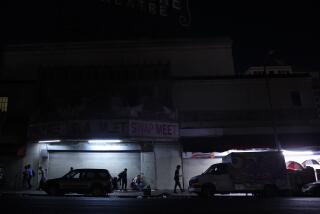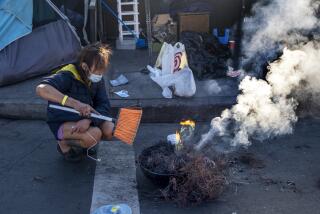Crime falls 40% in neighborhoods with Summer Night Lights program
Serious gang-related crime has tumbled 40% over the last three years in the troubled neighborhoods surrounding the sites of Summer Night Lights, Los Angelesâ park program designed to curb violence, newly assembled police data show.
This was the third summer that City Hall has run Summer Night Lights, offering recreational activities, mentoring and counseling programs, meals and other services at parks and public housing complexes.
Launched in the summer of 2008, Summer Night Lights expanded to 24 sites this year. Hours at each site were extended until midnight four days a week in the effort to provide safe, healthful activities in the hours when most violent crime occurs.
The programâs backers have reason to tout the crime-reduction data. Some city officials hope to expand to 32 sites next summer, even though Los Angeles is facing, by some estimates, a $320-million budget shortfall.
Crime has long been falling across Los Angeles; overall, crime has declined by 7.5% so far this year and is on pace to fall citywide for the ninth consecutive year. But serious gang-related crime â including murder, rape and robbery â has in many cases fallen at even greater rates in the neighborhoods surrounding Summer Night Lights sites. For example, in the 10 neighborhoods where the city added Summer Night Lights programs in 2010, serious gang-related crime fell 39.7% this summer.
Some of the declines at the new sites were striking â from 19 serious crimes to six in the neighborhood surrounding Highland Park Recreation Center; from 35 to 16 near the Van Ness Recreation Center.
Overall, serious gang-related crime has fallen 40.4% in the Summer Night Lights neighborhoods when compared with the summer of 2007, the summer before the program began.
âThere are not many places other than Summer Night Lights where people allow their kids to be in that kind of setting,â said Jerald Cavitt, a veteran gang-intervention worker and a coordinator of Summer Night Lights programming at Mt. Carmel Recreation Center in the Vermont-Slauson neighborhood of South L.A. In these neighborhoods, Cavitt said, âyou just donât play sports until 12 at night. We had skateboarding, popcorn and movie nights, intervention, mentoring â you name it.â
An audit found that residents made 710,000 visits to the 24 sites between July 7 and Sept. 4 this summer. On average, 10,929 people were served free meals each night.
âYou are there to feed these neighborhoods, literally and symbolically,â said Deputy Mayor Guillermo Cespedes, who runs City Hallâs Office of Gang Reduction and Youth Development and is an architect of the program. âThis isnât a soup kitchen. This is literally nourishing the neighborhood.â
The program cost roughly $5.4 million; half of that came from private donors and half from public sources. Cespedes said he is sensitive to the fact that Los Angeles is in dire financial straits, but he noted that violent crime comes with significant costs of its own.
One recent academic study determined that homicides cost the public more than $17 million apiece in justice system costs, lost productivity and efforts to combat future crime. From 2009 to 2010, gang-related homicides in the neighborhoods surrounding the 10 newly added sites fell from nine to three.
âThese neighborhoods are capable of transforming themselves away from violence,â Cespedes said. âThey will choose this over body bags. Thatâs what happened this summer.... In a time of budget crisis, the city cannot afford to not do this program. It doesnât solve all of the problems we need to solve. But it is a wise strategy.â
More to Read
Sign up for Essential California
The most important California stories and recommendations in your inbox every morning.
You may occasionally receive promotional content from the Los Angeles Times.











